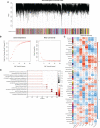Identification of pyroptosis-related subtypes and establishment of prognostic model and immune characteristics in asthma
- PMID: 35967302
- PMCID: PMC9368761
- DOI: 10.3389/fimmu.2022.937832
Identification of pyroptosis-related subtypes and establishment of prognostic model and immune characteristics in asthma
Abstract
Background: Although studies have shown that cell pyroptosis is involved in the progression of asthma, a systematic analysis of the clinical significance of pyroptosis-related genes (PRGs) cooperating with immune cells in asthma patients is still lacking.
Methods: Transcriptome sequencing datasets from patients with different disease courses were used to screen pyroptosis-related differentially expressed genes and perform biological function analysis. Clustering based on K-means unsupervised clustering method is performed to identify pyroptosis-related subtypes in asthma and explore biological functional characteristics of poorly controlled subtypes. Diagnostic markers between subtypes were screened and validated using an asthma mouse model. The infiltration of immune cells in airway epithelium was evaluated based on CIBERSORT, and the correlation between diagnostic markers and immune cells was analyzed. Finally, a risk prediction model was established and experimentally verified using differentially expressed genes between pyroptosis subtypes in combination with asthma control. The cMAP database and molecular docking were utilized to predict potential therapeutic drugs.
Results: Nineteen differentially expressed PRGs and two subtypes were identified between patients with mild-to-moderate and severe asthma conditions. Significant differences were observed in asthma control and FEV1 reversibility between the two subtypes. Poor control subtypes were closely related to glucocorticoid resistance and airway remodeling. BNIP3 was identified as a diagnostic marker and associated with immune cell infiltration such as, M2 macrophages. The risk prediction model containing four genes has accurate classification efficiency and prediction value. Small molecules obtained from the cMAP database that may have therapeutic effects on asthma are mainly DPP4 inhibitors.
Conclusion: Pyroptosis and its mediated immune phenotype are crucial in the occurrence, development, and prognosis of asthma. The predictive models and drugs developed on the basis of PRGs may provide new solutions for the management of asthma.
Keywords: DPP4; asthma; immune cell; prognostic model; pyroptosis-related genes.
Copyright © 2022 Yang, Wang, Yan, Li, Kong, Zong, Chao, Li, Zhao and Wang.
Conflict of interest statement
The authors declare that the research was conducted in the absence of any commercial or financial relationships that could be construed as a potential conflict of interest.
Figures








Similar articles
-
Exploring hub pyroptosis-related genes, molecular subtypes, and potential drugs in ankylosing spondylitis by comprehensive bioinformatics analysis and molecular docking.BMC Musculoskelet Disord. 2023 Jun 29;24(1):532. doi: 10.1186/s12891-023-06664-8. BMC Musculoskelet Disord. 2023. PMID: 37386410 Free PMC article.
-
Autophagy-Related Genes Are Involved in the Progression and Prognosis of Asthma and Regulate the Immune Microenvironment.Front Immunol. 2022 May 10;13:897835. doi: 10.3389/fimmu.2022.897835. eCollection 2022. Front Immunol. 2022. PMID: 35619697 Free PMC article.
-
A pyroptosis-related gene signature predicts prognosis and immune microenvironment in hepatocellular carcinoma.World J Surg Oncol. 2022 Jun 3;20(1):179. doi: 10.1186/s12957-022-02617-y. World J Surg Oncol. 2022. PMID: 35659304 Free PMC article.
-
Systematic transcriptome profiling of pyroptosis related signature for predicting prognosis and immune landscape in lower grade glioma.BMC Cancer. 2022 Aug 13;22(1):885. doi: 10.1186/s12885-022-09982-7. BMC Cancer. 2022. PMID: 35964070 Free PMC article.
-
Identification of Asthma Subtypes Using Clustering Methodologies.Pulm Ther. 2016;2:19-41. doi: 10.1007/s41030-016-0017-z. Epub 2016 Jun 22. Pulm Ther. 2016. PMID: 27512723 Free PMC article. Review.
Cited by
-
Programmed Cell Death in Asthma: Apoptosis, Autophagy, Pyroptosis, Ferroptosis, and Necroptosis.J Inflamm Res. 2023 Jul 1;16:2727-2754. doi: 10.2147/JIR.S417801. eCollection 2023. J Inflamm Res. 2023. PMID: 37415620 Free PMC article. Review.
-
Comprehensive Genome and Transcriptome Analysis Identifies SLCO3A1 Associated with Aggressive Behavior in Pigs.Biomolecules. 2023 Sep 12;13(9):1381. doi: 10.3390/biom13091381. Biomolecules. 2023. PMID: 37759782 Free PMC article.
-
Prognostic value of anoikis-related genes revealed using multi-omics analysis and machine learning based on lower-grade glioma features and tumor immune microenvironment.Heliyon. 2024 Aug 28;10(17):e36989. doi: 10.1016/j.heliyon.2024.e36989. eCollection 2024 Sep 15. Heliyon. 2024. PMID: 39286119 Free PMC article.
-
Identification of biomarkers associated with mitochondrial dysfunction and programmed cell death in chronic obstructive pulmonary disease via transcriptomics.Front Genet. 2025 Jun 19;16:1567173. doi: 10.3389/fgene.2025.1567173. eCollection 2025. Front Genet. 2025. PMID: 40612794 Free PMC article.
-
Construction and verification of atopic dermatitis diagnostic model based on pyroptosis related biological markers using machine learning methods.BMC Med Genomics. 2023 Jun 17;16(1):138. doi: 10.1186/s12920-023-01552-5. BMC Med Genomics. 2023. PMID: 37330465 Free PMC article.
References
Publication types
MeSH terms
LinkOut - more resources
Full Text Sources
Medical
Miscellaneous

